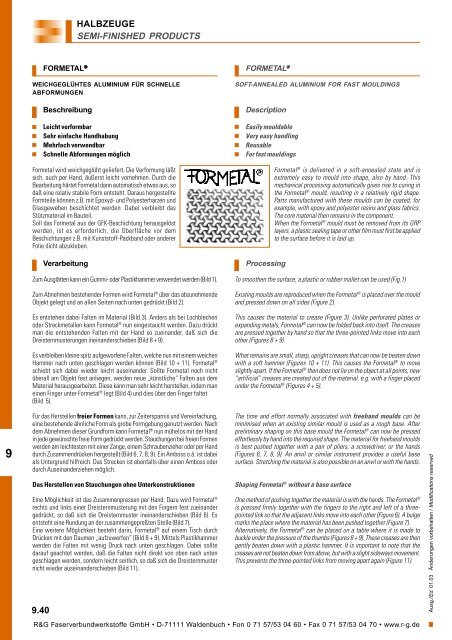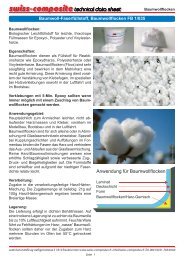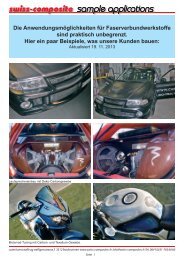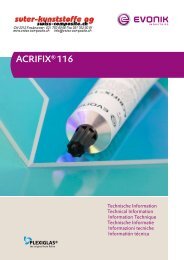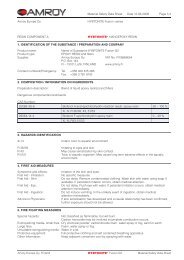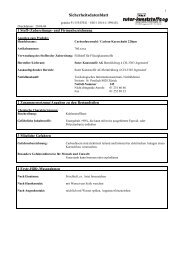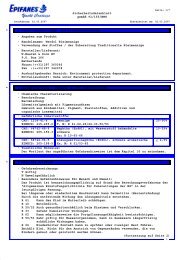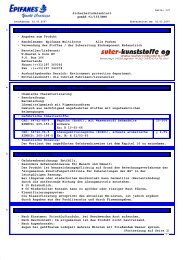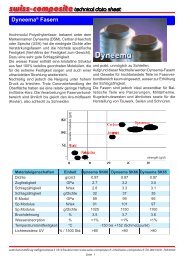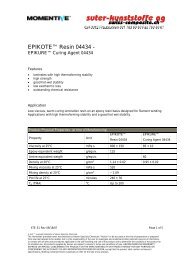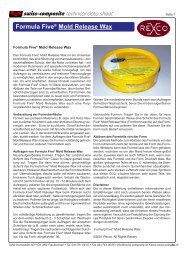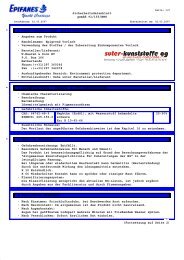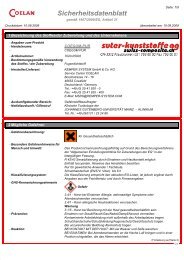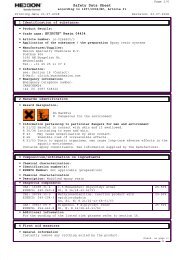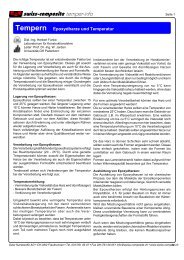Handbuch - Suter Swiss-Composite Group
Handbuch - Suter Swiss-Composite Group
Handbuch - Suter Swiss-Composite Group
Erfolgreiche ePaper selbst erstellen
Machen Sie aus Ihren PDF Publikationen ein blätterbares Flipbook mit unserer einzigartigen Google optimierten e-Paper Software.
9<br />
WEICHGEGLÜHTES ALUMINIUM FÜR SCHNELLE<br />
ABFORMUNGEN<br />
Beschreibung<br />
Leicht verformbar<br />
Sehr einfache Handhabung<br />
Mehrfach verwendbar<br />
Schnelle Abformungen möglich<br />
Formetal wird weichgeglüht geliefert. Die Verformung läßt<br />
sich, auch per Hand, äußerst leicht vornehmen. Durch die<br />
Bearbeitung härtet Formetal dann automatisch etwas aus, so<br />
daß eine relativ stabile Form entsteht. Daraus hergestellte<br />
Formteile können z.B. mit Epoxyd- und Polyesterharzen und<br />
Glasgeweben beschichtet werden. Dabei verbleibt das<br />
Stützmaterial im Bauteil.<br />
Soll das Formetal aus der GFK-Beschichtung herausgelöst<br />
werden, ist es erforderlich, die Oberfläche vor dem<br />
Beschichtungen z.B. mit Kunststoff-Packband oder anderer<br />
Folie dicht abzukleben.<br />
Verarbeitung<br />
Zum Ausglätten kann ein Gummi- oder Plastikhammer verwendet werden (Bild 1).<br />
Zum Abnehmen bestehender Formen wird Formetal ® über das abzunehmende<br />
Objekt gelegt und an allen Seiten nach unten gedrückt (Bild 2).<br />
Es entstehen dabei Falten im Material (Bild 3). Anders als bei Lochblechen<br />
oder Streckmetallen kann Formetal ® nun eingestaucht werden. Dazu drückt<br />
man die entstehenden Falten mit der Hand so zueinander, daß sich die<br />
Dreisternmusterungen ineinanderschieben (Bild 8 + 9).<br />
Es verbleiben kleine spitz aufgeworfene Falten, welche nun mit einem weichen<br />
Hammer nach unten geschlagen werden können (Bild 10 + 11). Formetal ®<br />
schiebt sich dabei wieder leicht auseinander. Sollte Formetal noch nicht<br />
überall am Objekt fest anliegen, werden neue „künstliche“ Falten aus dem<br />
Material herausgearbeitet. Diese kann man sehr leicht herstellen, indem man<br />
einen Finger unter Formetal ® legt (Bild 4) und dies über den Finger faltet<br />
(Bild 5).<br />
Für das Herstellen freier Formen kann, zur Zeitersparnis und Vereinfachung,<br />
eine bestehende ähnliche Form als grobe Formgebung genutzt werden. Nach<br />
dem Abnehmen dieser Grundform kann Formetal ® nun mühelos mit der Hand<br />
in jede gewünschte freie Form gedrückt werden. Stauchungen bei freien Formen<br />
werden am leichtesten mit einer Zange, einem Schraubenzieher oder per Hand<br />
durch Zusammendrücken hergestellt (Bild 6, 7, 8, 9). Ein Amboss o.ä. ist dabei<br />
als Untergrund hilfreich. Das Strecken ist ebenfalls über einen Amboss oder<br />
durch Auseinanderziehen möglich.<br />
Das Herstellen von Stauchungen ohne Unterkonstruktionen<br />
Eine Möglichkeit ist das Zusammenpressen per Hand. Dazu wird Formetal ®<br />
rechts und links einer Dreisternmusterung mit den Fingern fest zueinander<br />
gedrückt, so daß sich die Dreisternmuster ineinanderschieben (Bild 6). Es<br />
entsteht eine Rundung an der zusammengepreßten Stelle (Bild 7).<br />
Eine weitere Möglichkeit besteht darin, Formetal ® auf einem Tisch durch<br />
Drücken mit den Daumen „aufzuwerfen“ (Bild 8 + 9). Mittels Plastikhammer<br />
werden die Falten mit wenig Druck nach unten geschlagen. Dabei sollte<br />
darauf geachtet werden, daß die Falten nicht direkt von oben nach unten<br />
geschlagen werden, sondern leicht seitlich, so daß sich die Dreisternmuster<br />
nicht wieder auseinanderschieben (Bild 11).<br />
9.40<br />
FORMETAL ®<br />
HALBZEUGE<br />
SEMI-FINISHED PRODUCTS<br />
FORMETAL ®®®®®<br />
SOFT-ANNEALED ALUMINIUM FOR FAST MOULDINGS<br />
Description<br />
Easily mouldable<br />
Very easy handling<br />
Reusable<br />
For fast mouldings<br />
Processing<br />
Formetal ® is delivered in a soft-annealed state and is<br />
extremely easy to mould into shape, also by hand. This<br />
mechanical processing automatically gives rise to curing in<br />
the Formetal ® mould, resulting in a relatively rigid shape.<br />
Parts manufactured with these moulds can be coated, for<br />
example, with epoxy and polyester resins and glass fabrics.<br />
The core material then remains in the component.<br />
When the Formetal ® mould must be removed from its GRP<br />
layers, a plastic sealing tape or other film must first be applied<br />
to the surface before it is laid up.<br />
To smoothen the surface, a plastic or rubber mallet can be used (Fig.1)<br />
Existing moulds are reproduced when the Formetal ® is placed over the mould<br />
and pressed down on all sides (Figure 2).<br />
This causes the material to crease (Figure 3). Unlike perforated plates or<br />
expanding metals, Formetal ® can now be folded back into itself. The creases<br />
are pressed together by hand so that the three-pointed links move into each<br />
other (Figures 8 + 9).<br />
What remains are small, sharp, upright creases that can now be beaten down<br />
with a soft hammer (Figures 10 + 11). This causes the Formetal ® to move<br />
slightly apart. If the Formetal ® then does not lie on the object at all points, new<br />
“artificial” creases are created out of the material, e.g. with a finger placed<br />
under the Formetal ® (Figures 4 + 5).<br />
The time and effort normally associated with freehand moulds can be<br />
minimised when an existing similar mould is used as a rough base. After<br />
preliminary shaping on this base mould the Formetal ® can now be pressed<br />
effortlessly by hand into the required shape. The material for freehand moulds<br />
is best pushed together with a pair of pliers, a screwdriver, or the hands<br />
(Figures 6, 7, 8, 9). An anvil or similar instrument provides a useful base<br />
surface. Stretching the material is also possible on an anvil or with the hands.<br />
Shaping Formetal ® without a base surface<br />
One method of pushing together the material is with the hands. The Formetal ®<br />
is pressed firmly together with the fingers to the right and left of a threepointed<br />
link so that the adjacent links move into each other (Figure 6). A bulge<br />
marks the place where the material has been pushed together (Figure 7).<br />
Alternatively, the Formetal ® can be placed on a table where it is made to<br />
buckle under the pressure of the thumbs (Figures 8 + 9). These creases are then<br />
gently beaten down with a plastic hammer. It is important to note that the<br />
creases are not beaten down from above, but with a slight sideways movement.<br />
This prevents the three-pointed links from moving apart again (Figure 11).<br />
R&G Faserverbundwerkstoffe GmbH D-71111 Waldenbuch Fon 0 71 57/53 04 60 Fax 0 71 57/53 04 70 www.r-g.de<br />
Ausg./Ed. 01.03 Änderungen vorbehalten / Modifications reserved


